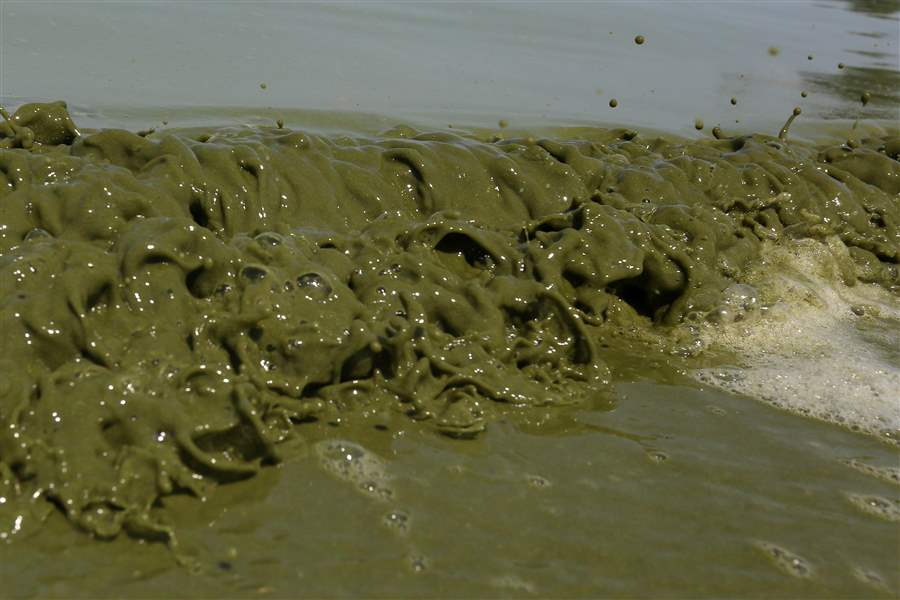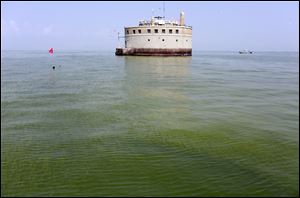
Judge says he may back away from Lake Erie algae lawsuit
5/23/2018
Thick algae floats in Lake Erie at Maumee Bay State Park. Judge James Carr says nobody can dispute the lake is sick.
The Blade
Buy This Image
While still clearly disgusted by the lack of progress toward solving western Lake Erie’s chronic algae problem, U.S. District Judge James Carr has left open the possibility of eventually backing away from the case in front of him — but only if there comes a point in time in which state and federal agencies convince him they are taking the public health threat seriously enough.

The water intake crib for the city of Toledo is surrounded by an algae bloom in 2014.
Right now, the judge said, they’re not.
Throughout a two-hour discussion in open court Wednesday with lawyers from the U.S. Department of Justice and the Chicago-based Environmental Law and Policy Center, Judge Carr underscored his desire to see the U.S. Environmental Protection Agency and its state partner, the Ohio Environmental Protection Agency, become “truly aggressive” and said they “should treat this as a grave condition.”
But Judge Carr, who in an April 10 filing accused those two agencies of botching the Lake Erie impairment controversy, also broadened his appeal to members of the Ohio General Assembly — especially conservatives who have made it virtually impossible to pass stricter rules on agriculture. He likewise implored agencies such as the Ohio Department of Agriculture to make algae-prevention their No. 1 priority.
Nobody, he said, can dispute Lake Erie is “sick.”
Judge Carr said the time has come for tougher rules — though he also said he’d rather not have them come from the judiciary.
“I think it's pretty clear that purely voluntary compliance is not going to get us very far,” he said. “These [regulations on agriculture] are responsibilities that belong to the legislative and executive branches of government.”

Judge James Carr
Judge Carr said he’d rather give agencies the chance to do more because “the judiciary is the clumsiest of all instruments” and is “really the branch of last resort.”
“We hit with a sledgehammer. We don't operate with a scalpel,” he said. “Candidly, as a judge, I would exhort those agencies [to do more].”
The case was filed by the ELPC last year against the U.S. EPA because the federal agency originally went along with the Ohio EPA’s plan to leave western Lake Erie off its 2016 list of impaired waterways while Michigan did not.
Both the U.S. and Ohio environmental agencies ultimately changed their minds because of the lawsuit. The U.S. EPA contends the case is now moot, but Judge Carr has agreed to maintain jurisdiction over it to ensure there is meaningful action taken to address the impairment designation.
The hearing ended with the judge telling Daniel Dertke and Jody L. King, two assistant U.S. attorneys defending the U.S. EPA, and Madeline Fleisher, ELPC attorney, to give him a status report this fall on what the agencies are doing, and what the Ohio General Assembly is doing. He told them to plan to be back in court in late October or early November. The judge, who has lived in western Massachusetts since the summer of 2016, makes only occasional visits to the federal court building in Toledo.
Attorneys began the session arguing over whether Judge Carr should order a highly restrictive planning document known as a “total maximum daily load,” or TMDL, which puts a firm cap on pollutants that can be put upon a river, lake, stream, or ecosystem.
Though many TMDLs are in Ohio, none are for bodies of water as large as western Lake Erie. The closest equivalent is a TMDL developed by six states for the Chesapeake Bay.
The two federal attorneys maintain Judge Carr doesn’t have the authority to issue a TMDL. Ms. Fleisher encouraged him to do that because the Kasich administration has said it won’t develop one unless ordered by the court. TMDLs, she said, often come after bodies of water are designated as impaired under the federal Clean Water Act, which the Kasich administration finally did in March after years of resistance on behalf of agriculture.
When asked about Judge Carr’s comment on the judiciary being the last resort, Ms. Fleisher responded: “I think that’s an accurate description of where we are. It’s been a long time and a lot of algae.”
The lake’s algal blooms are of high importance to public health officials because they carry a toxin, microcystin, that is capable of killing humans. The modern era for those blooms began in 1995. Similar — though not identical — summertime blooms occurred for decades until the early 1970s.
An algae conference was held the same day at the Toledo Club, co-sponsored by the Toledo law firm of Shumaker, Loop & Kendrick, and Ramboll, a Denmark-based firm with 13,000 consulting engineers, designers, and management consultants.
Lou Tosi, one of the law firm’s partners, served as moderator. He cited a news article that stated Gov. John Kasich was getting so frustrated by his own party’s resistance for tighter controls on algae-forming runoff that he might unilaterally impose his own rules before he leaves office.
Mr. Tosi also said it doesn’t appear a bill being pushed by the Kasich administration to help Lake Erie is going anywhere. It calls for tougher rules, including manure-management plans, on watersheds that Ohio Department of Agriculture Director David Daniels has identified as distressed from pollution.
“The legislation is dead. It doesn't have any support in the Ohio General Assembly, Mr. Tosi said.
That conference, which drew nearly 100 people, featured a presentation by Karl Gebhardt, Ohio EPA deputy director for water resources and the administration’s coordinator of Lake Erie programs.
Another speaker, Robin L. Richards, a Ramboll principal who has been involved in the Chesapeake Bay cleanup, said the TMDL process was probably less complicated there than one would be here because — even though there are six states involved — it’s all within the United States.
A western Lake Erie TMDL would, ideally, include two nations — the United States and Canada — as well as the states of Ohio, Michigan, Indiana, and the province of Ontario.
“Certainly, the Chesapeake Bay benefited from having a tremendous amount of federal funding,” Ms. Richards said. “In the Chesapeake Bay, each state got a pollution diet.”
Contact Tom Henry at thenry@theblade.com, 419-724-6079, or via Twitter @ecowriterohio.